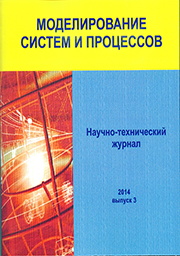There is a problem of ecological forecasting identification which is finding power sources for the available experimental data. This task is an inverse problem, the solution of which will be considered by applying the method of symbolic regression. The artificial immune system (AIS) – a model that allows you to solve various problems of recognition, its concept was borrowed from biology. This distributed network can operate in any heterogeneous environment, which is achieved through the use of cross-platform programming language Python. AIS demonstrates the ability to restore the original function in the identification problem, a plot of the solution for test data is presented.
artificial immune systems, symbolic regression, distributed algorithms, problem of identification in ecology.
I. Введение
Искусственная иммунная система (ИИС) – модель, позволяющая решать различные задачи распознавания, ее концепция была заимствована из биологии. Как и естественная иммунная система в организме, ИИС способна распознавать широкий класс входных данных. В данной задаче используется ИИС для решения задачи символьной регрессии. Ее элементарными элементами являются лимфоциты, представляющие собой различные функции в виде деревьев выражений. К лимфоцитам в течение всего функционирования искусственной иммунной системы применяются различные операции мутации, но при этом поддерживается постоянный размер сети, что достигается удалением плохо приспособленных лимфоцитов, целевая функция (функция приспособленности) называется аффинностью.
Аффинностью будем пользоваться для оценки операций. Распределенность достигается существованием различных искусственных иммунных систем на различных вычислительных узлах, которые обмениваются накопленной информацией.
Одноранговая, децентрализованная или пиринговая сеть – это компьютерная сеть, основанная на равноправии участников. В такой сети отсутствуют выделенные серверы, а каждый узел (peer) является как клиентом, так и сервером. В отличие от архитектуры клиент-сервер, такая организация позволяет сохранять работоспособность сети при любом количестве и любом сочетании доступных узлов.
Искусственные иммунные системы – наиболее молодая отрасль искусственного интеллекта [2, 9]. Они применяются для решения различных задач [3, 11], среди которых разнообразные задачи оптимизации [4], распознавания [6], управление автономными роботами [7]. В данной статье искусственная иммунная система применяется для решения задачи символьной регрессии [8], к которой сводится задача идентификации в экологии. Эта задача состоит в восстановлении функций мощности источников загрязнения по показаниям датчиков [1]. Для ускорения решения используется распределенная версия искусственной иммунной системы.
1. Vasil´ev, A. N. Parametricheskie neyrosetevye modeli postroeniya regulyarizatsii resheniya zadachi identifikatsii v ekologii [Tekst] / A. N. Vasil´ev, D. A. Tarkhov. Sovremennye informatsionnye tekhnologii i IT-obrazovanie. - 2014. - T. 1. - № 1 (9). - S. 470-475.
2. Iskusstvennye immunnye sistemy i ikh primenenie [Tekst] : sb. statey / pod red. D. Dasgupty - M. : Fizmatlit, 2006 - 344 s.
3. Dasgupta, D. Recent Advances in Artificial Immune Systems: Models and Applications / D. Dasgupta, S. Yua, F. Nino. Applied Soft Computing. - 2011. - Vol. 11.- P. 1574-1587.
4. Freschi, F. Multiobjective optimisation by a modified artificial immune system / F. Freschi, M. Repetto. Artificial Immune Systems. - 2005. - P. 248-261
5. Hoai, N.X. Solving the symbolic regression problem with tree-adjunct grammar guided genetic programming: the comparative results / N.X. Hoai, R.I. McKay, D. Essam. Evolutionary Computation, CEC ´02. Proceedings of the 2002 Congress. - 2002. - Vol. 2.- P.1326-1331.
6. Hunt, I.E. Learning using an artificial immune system / I. E. Hunt, D. E. Cooke. Journal of Network and Computer Applications. - 1996. - Vol. 19. - P. 189-212.
7. Ishiguro, A. A Robot with a Decentralized Consensus-Making Mechanism Based on the Immune System / A. Ishiguro, Y. Watanabe, T. Kondo. Proceedings of ISADS. - 1997. - P. 231-237.
8. Johnson, C.G. Artificial Immune Systems Programming for Symbolic Regression / C. G. Johnson. Genetic Programming: 6th European Conference. - 2003. - P. 345-353.
9. Kephart, J. O. A biologically inspired immune system for computers / J. O. Kephart. Proceedings of Artificial Life IV: The Fourth International Workshop on the Synthesis and Simulation of Living Systems. - 1994. - P. 130-139.
10. Schollmeier, R. A Definition of Peer-to-Peer Networking for the Classification of Peer-to-Peer Architectures and Applications / R. Schollmeier. Proceedings of the First International Conference on Peer-to-Peer Computing, IEEE. - 2001. - P. 101-102.
11. Timmis, J. Application areas of AIS: The past, the present and the future / E. Hart, J. Timmis. Applied Soft Computing. - 2008. - Vol. 8. - P. 191-201.
12. Bardeen, M. Survey of Methods to Prevent Premature Convergence in Evolutionary Algorithms / M. Bardeen. Workshop of Natural Computing, Jornadas Chilenas de Computacion. - 2013. - P. 13-15.
13. Barkai, D. Peer-to-Peer Computing / D. Barkai. - Santa Clara: Intel Press, 2002. - 78 p.
14. Bennett, K. A Genetic Algorithm for Database Query Optimization / K. Bennett, M. C. Ferris, Y. E. Ioannidis. Proceedings of the fourth International Conference on Genetic Algorithms. - 1991. - P. 400-407.
15. Bersini, H. The Endogenous Double Plasticity of the Immune Network and the Inspiration to be drawn for Engineering Artifacts / H. Bersini. Artificial Immune Systems and Their Applications. - 1999. - P. 22-44.





